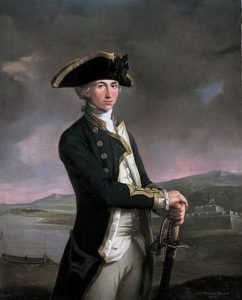Young Captain Nelson Rescues men from the Burning Glasgow – 1 June 1779
At 3.30 on the afternoon of 1 June the twenty-two year old sloop Glasgow 20, Commander Thomas Lloyd, dropped anchor in Montego Bay, Jamaica, having arrived with a convoy of four London merchantmen. Aboard the Glasgow, which had left England on 27 March, was a valuable and volatile cargo of gunpowder.
Some two and a half hours later smoke was seen drifting skywards from one of the Glasgow s quarterdeck hatchways, and soon she was irrecoverably aflame. Fortunately for Captain Lloyd and his crew however, the brig Badger 14 was at anchor nearby. Her commanding officer, the hitherto largely unknown Horatio Nelson, was quickly alerted to the fire by Lieutenant Richard Oakley, an officer of one year s seniority who had been away from the Glasgow on boat duty, and who had spotted the smoke emanating from her. Nelson ordered a number of buckets down into Oakley s boat for immediate conveyance to the stricken sloop, and he then set off with his own boats and two from the convoy to assist the Glasgow.
Aboard his ill-feted command Captain Lloyd and his crew were valiantly yet calmly fighting the fire by drawing water from over the side and soaking the seamen s hammocks to throw down upon the flames. Meanwhile the gunner and Lieutenant Oakley, who had by now scrambled back aboard, had broken into the magazine and were sending the casks of gunpowder along the sloop towards the fore hatchway. This was in accordance with Lloyd s order that nobody would be allowed to abandon ship until all the powder had been hove over the side, for the risk of the fire reaching the powder was that the inevitable explosion would not only set alight the ships in the anchorage but also the nearby town of Kingston. Lloyd also ordered his gun crews to point their cannon skywards so that any residue shot would not be discharged when the fire reached them, and these instructions were repeated by Nelson when he got alongside in his own boat.
By 7.15 the fire had spread over the whole quarterdeck and the flames were engulfing the main and mizzen rigging. With the last of the powder being safely jettisoned the order was given to abandon ship, and the boats moved up to the bow of the Glasgow to take her men off under the supervision of Captain Lloyd, who had assumed a perilous position on the boom. At 8.30, her anchor having been cut away, the sloop was taken in tow and was hauled off to be cast loose on a land wind that drifted her out to sea. Her end came at midnight when an explosion ripped her apart.
After abandoning their sloop the Glasgow s crew of one hundred and sixty men were taken aboard the Badger for passage to Port Royal. Their additional number brought severe overcrowding to a vessel whose crew were already suffering from the fever, and a continual rain only added to the misery of the shipwrecked seamen as they huddled together on the exposed deck. Nelson observed that Captain Lloyd was very melancholy indeed and noted that the admirable Lieutenant Oakley had managed to escape with nothing more than the clothes he had been wearing. The Glasgow s master, James Cobby, was not even that lucky, for the burns he had sustained in the fire resulted in his death at 7 o clock the following morning.
The Glasgow s loss was attributed to the thievery of the purser s steward, Richard Brace, who had gone below with a lighted candle to draw rum from the after-hold, and in the process of so doing had dropped the candle into the cask of alcohol. Following the subsequent court at Port Royal aboard the Bristol 50, flagship of the commander-in-chief, Vice-Admiral Sir Peter Parker, Captain Lloyd was honourably acquitted of any blame for his ship s loss, being praised for his remarkable conduct. The culprit Brace was sentenced to receive a hundred lashes. Nelson appears to have given a fair account of the affair, and he added little of the personal embellishment that would colour his future exploits. Unfortunately the same could not be said of his later biographers who sought to credit him alone for the sensible measures taken by Captain Lloyd during the unfortunate incident.
Captain Lloyd did not have to wait long for another ship, for having been appointed to the Portland 50 he went out to the Newfoundland station in May of the following year with the flag of the commander-in-chief, Rear-Admiral Richard Edwards. After seeing further service in the American Revolutionary War he retired to his Welsh estate at the peace.
Lieutenant Oakley was raised to the rank of commander in 1782 but had to wait another twenty-seven years before being posted captain. Having never commanded a ship at sea he died in his apartments in the Strand, London, during January 1815, which by a quirk of fate was the same month that Nelson s future mistress, Lady Emma Hamilton died.

